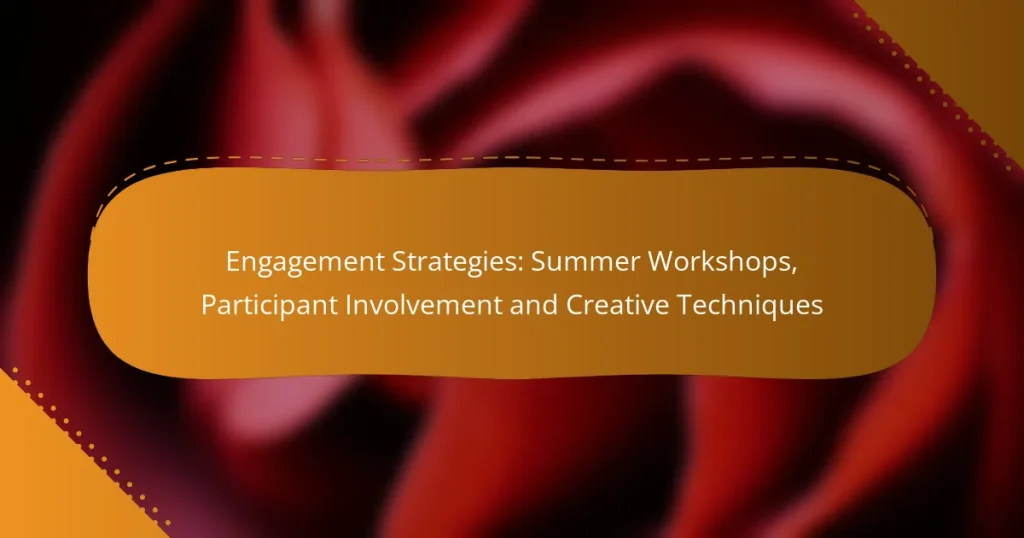Engaging participants in summer workshops requires a blend of interactive activities and creative techniques that foster involvement and enhance learning. By incorporating group discussions, hands-on projects, and innovative methods such as gamification and visual storytelling, facilitators can create a dynamic environment that encourages collaboration and creativity. These strategies not only enrich the participant experience but also promote a sense of community and shared learning.
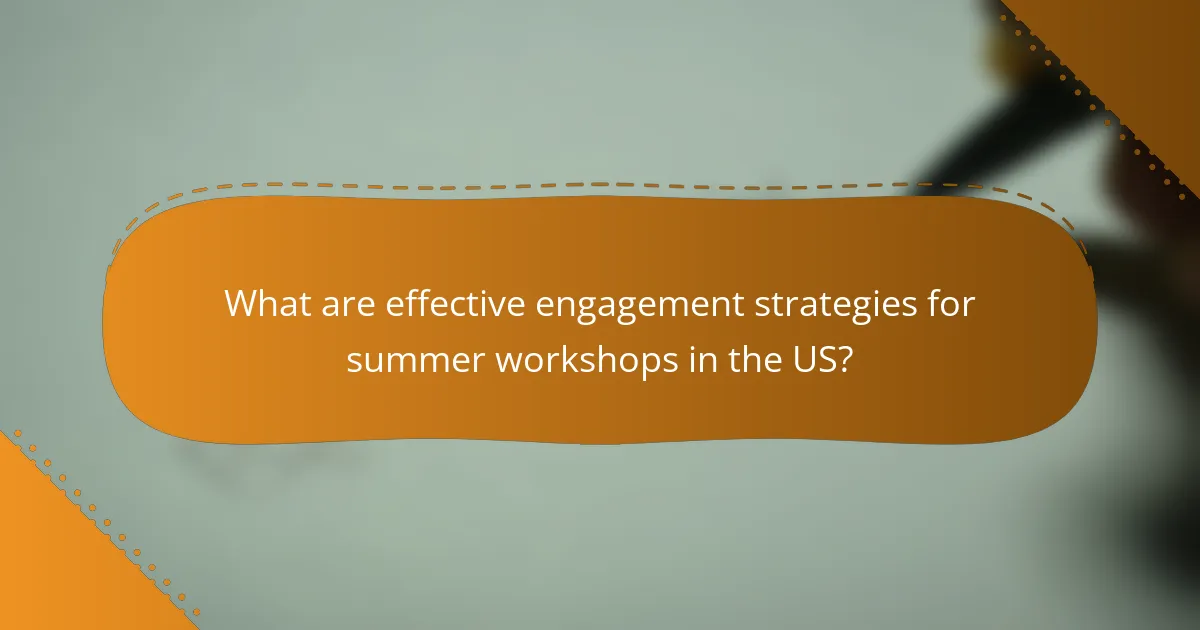
What are effective engagement strategies for summer workshops in the US?
Effective engagement strategies for summer workshops in the US include interactive activities, group discussions, hands-on projects, guest speakers, and networking opportunities. These methods foster participant involvement and enhance the overall learning experience.
Interactive activities
Interactive activities are essential for keeping participants engaged during summer workshops. These can include games, role-playing, or simulations that relate directly to the workshop’s content. Such activities encourage active participation and help reinforce learning through practical application.
Consider incorporating technology, like polling apps or interactive whiteboards, to make activities more dynamic. Aim for a balance between fun and educational value to maintain interest without losing focus on the workshop objectives.
Group discussions
Group discussions allow participants to share insights and perspectives, enhancing their understanding of the material. Facilitating small group conversations can create a comfortable environment for everyone to voice their thoughts and questions. This peer interaction often leads to deeper comprehension and retention of the subject matter.
To maximize effectiveness, provide clear discussion prompts and set time limits. Encourage participants to summarize key points at the end to reinforce learning and ensure everyone is on the same page.
Hands-on projects
Hands-on projects are a powerful way to engage participants by allowing them to apply concepts in real-world scenarios. These projects can range from creating prototypes to conducting experiments, depending on the workshop’s focus. Participants often find that practical experience solidifies their understanding more than theoretical learning alone.
When planning hands-on projects, ensure that materials and resources are readily available. Set clear objectives and provide guidance to help participants stay focused and productive throughout the activity.
Guest speakers
Inviting guest speakers can significantly enhance the workshop experience by providing expert insights and real-world applications of the topics discussed. Speakers can share their experiences, answer questions, and inspire participants with their knowledge. This exposure to industry professionals can also help participants envision potential career paths.
When selecting guest speakers, consider their relevance to the workshop theme and their ability to engage an audience. Prepare participants with background information about the speaker to foster a more meaningful interaction during the session.
Networking opportunities
Networking opportunities are crucial for participants to connect with peers and industry professionals. These interactions can lead to collaborations, mentorships, and future job opportunities. Incorporating dedicated networking sessions into the workshop schedule encourages attendees to build relationships that extend beyond the event.
Facilitate networking by creating informal settings, such as coffee breaks or social hours, where participants can mingle. Providing icebreaker activities can also help ease initial interactions and promote a welcoming atmosphere.
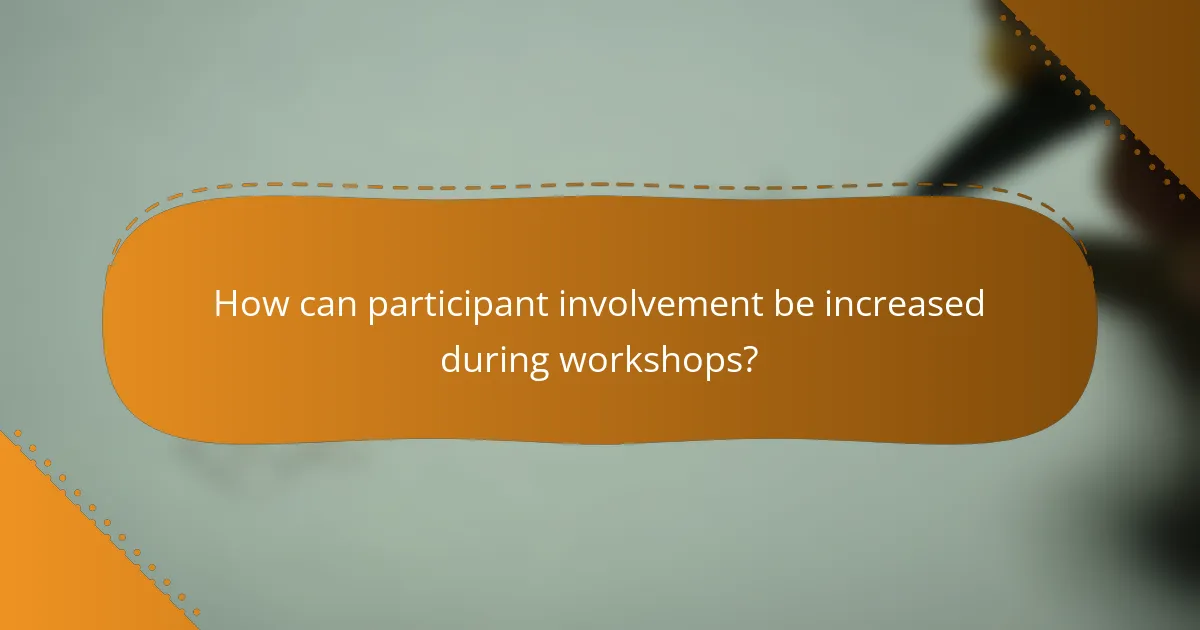
How can participant involvement be increased during workshops?
Increasing participant involvement during workshops can be achieved through various strategies that encourage engagement and interaction. By implementing effective techniques such as pre-workshop surveys and collaborative tasks, facilitators can create a more inclusive and dynamic environment.
Pre-workshop surveys
Pre-workshop surveys are an effective way to gauge participant interests and expectations. By collecting this information beforehand, facilitators can tailor the workshop content to align with attendees’ needs, making them feel valued and engaged from the start.
Consider using a mix of open-ended and multiple-choice questions to gather qualitative and quantitative data. Aim for a response rate of at least 70% to ensure diverse input, which can significantly inform your workshop design.
Feedback sessions
Incorporating feedback sessions during and after workshops allows participants to voice their opinions and suggestions. This practice not only fosters a sense of ownership but also helps facilitators adjust the flow of the workshop in real-time to better meet participant needs.
Schedule brief feedback intervals, perhaps every hour, to encourage ongoing dialogue. Use tools like anonymous polls or discussion boards to make it easier for participants to share their thoughts openly.
Incentives for participation
Offering incentives can significantly boost participant involvement. Consider providing small rewards such as gift cards, certificates, or exclusive content for active engagement during the workshop.
Clearly communicate the criteria for earning these incentives, whether it’s through participation in discussions or completing tasks. This approach can motivate attendees to contribute more actively.
Role assignments
Assigning specific roles to participants can enhance their involvement by giving them a clear purpose during the workshop. Roles could include group leader, note-taker, or presenter, depending on the workshop format.
Ensure that roles are rotated throughout the session to allow everyone the opportunity to engage in different capacities. This strategy not only diversifies participation but also builds teamwork and collaboration among attendees.
Collaborative tasks
Implementing collaborative tasks encourages participants to work together, fostering a sense of community and shared responsibility. Group activities, such as brainstorming sessions or problem-solving challenges, can significantly enhance engagement levels.
Design tasks that are relevant to the workshop’s objectives and allow for diverse contributions. Aim for groups of 3-5 participants to balance interaction and ensure that everyone has a chance to contribute meaningfully.
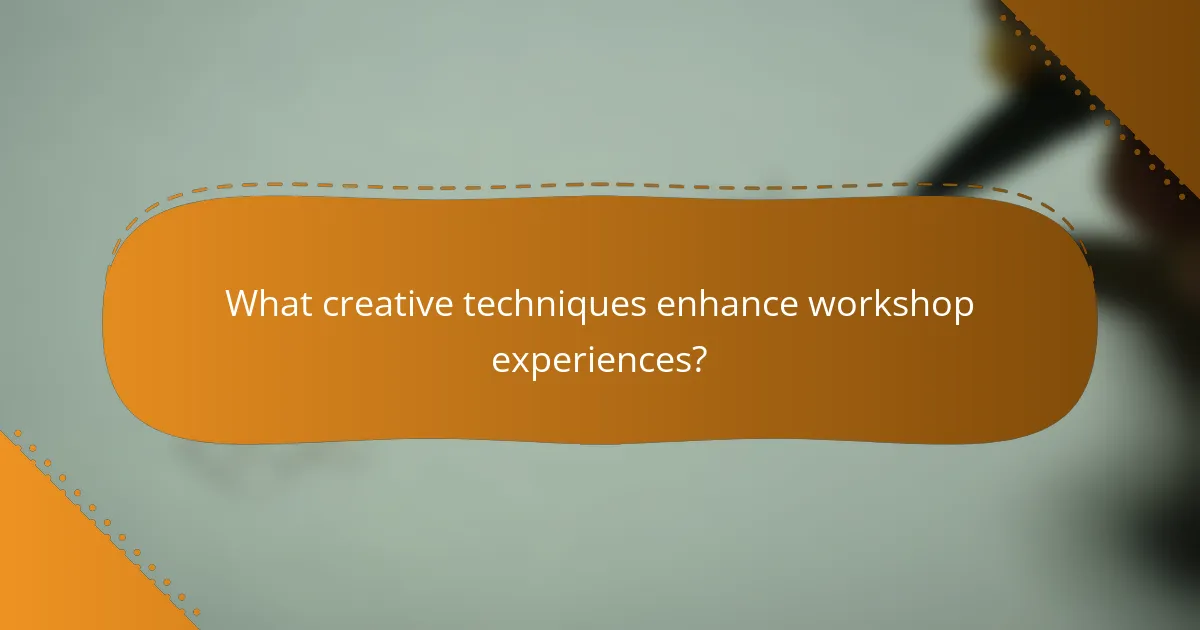
What creative techniques enhance workshop experiences?
Creative techniques can significantly elevate workshop experiences by fostering engagement and participation. Methods like visual storytelling, gamification, art-based activities, technology integration, and mindfulness practices can create a dynamic environment that encourages collaboration and creativity.
Visual storytelling
Visual storytelling involves using images, videos, and graphics to convey ideas and narratives. This technique can help participants connect emotionally with the content, making it more memorable. Consider incorporating slideshows or infographics that illustrate key points, enhancing understanding and retention.
To effectively use visual storytelling, ensure that visuals are relevant and high-quality. Avoid cluttered slides; instead, focus on a few impactful images that support your message. This approach can be particularly effective in workshops focused on design, marketing, or education.
Gamification elements
Gamification incorporates game-like elements into non-game contexts to boost motivation and engagement. Techniques such as point systems, leaderboards, and challenges can make learning more interactive and enjoyable. For example, you might create a friendly competition where participants earn points for completing tasks or contributing ideas.
When implementing gamification, be mindful of the balance between fun and learning. Ensure that game elements enhance the educational experience rather than distract from it. Consider using small rewards or recognition to encourage participation without overwhelming participants.
Art-based activities
Art-based activities encourage creativity and self-expression, allowing participants to explore concepts through various mediums like drawing, painting, or crafting. These activities can serve as icebreakers or as a way to deepen understanding of complex topics. For instance, participants might create a visual representation of their ideas or collaborate on a group mural.
To integrate art effectively, provide a variety of materials and clear instructions. Keep activities simple and focused to avoid frustration. This approach works well in workshops aimed at fostering innovation or team-building, as it promotes collaboration and communication.
Technology integration
Integrating technology into workshops can enhance learning experiences by providing interactive tools and resources. Utilizing platforms for virtual collaboration, interactive polls, or digital brainstorming can engage participants more effectively. For example, using apps like Miro or Mentimeter can facilitate real-time feedback and idea generation.
When incorporating technology, ensure that all participants are comfortable using the tools. Provide a brief tutorial if necessary, and consider having technical support available during the workshop. This can help prevent disruptions and keep the focus on learning.
Mindfulness practices
Mindfulness practices, such as guided meditation or breathing exercises, can help participants focus and reduce anxiety. Incorporating short mindfulness sessions at the beginning or during breaks can enhance overall engagement and well-being. For example, starting with a five-minute breathing exercise can set a calm tone for the workshop.
To implement mindfulness effectively, keep sessions brief and accessible. Encourage participants to share their experiences and feelings, fostering a supportive environment. This approach can be particularly beneficial in high-pressure workshops, helping to create a more relaxed and open atmosphere for learning.
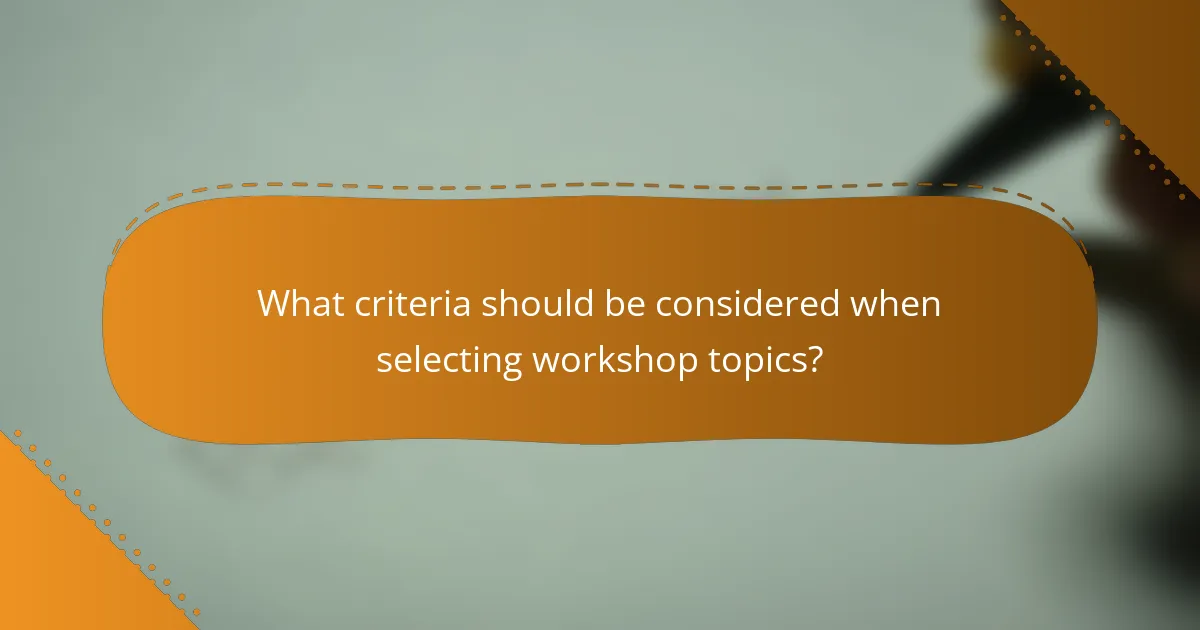
What criteria should be considered when selecting workshop topics?
Selecting workshop topics requires careful consideration of audience needs, relevance to current trends, and the potential for participant engagement. Effective topics resonate with participants, encouraging active involvement and creativity during the sessions.
Audience interests
Understanding audience interests is crucial for selecting relevant workshop topics. Conduct surveys or informal polls to gather insights about what participants are eager to learn or discuss. This direct feedback can guide topic selection and ensure higher engagement levels.
Consider the demographics of your audience, including age, profession, and cultural background. For example, younger audiences may prefer hands-on, technology-driven topics, while older participants might appreciate discussions on traditional techniques or industry trends.
Additionally, keep an eye on emerging trends related to your field. Topics that align with current events or popular movements can attract more participants. For instance, workshops on sustainability practices are increasingly popular as environmental awareness grows.
